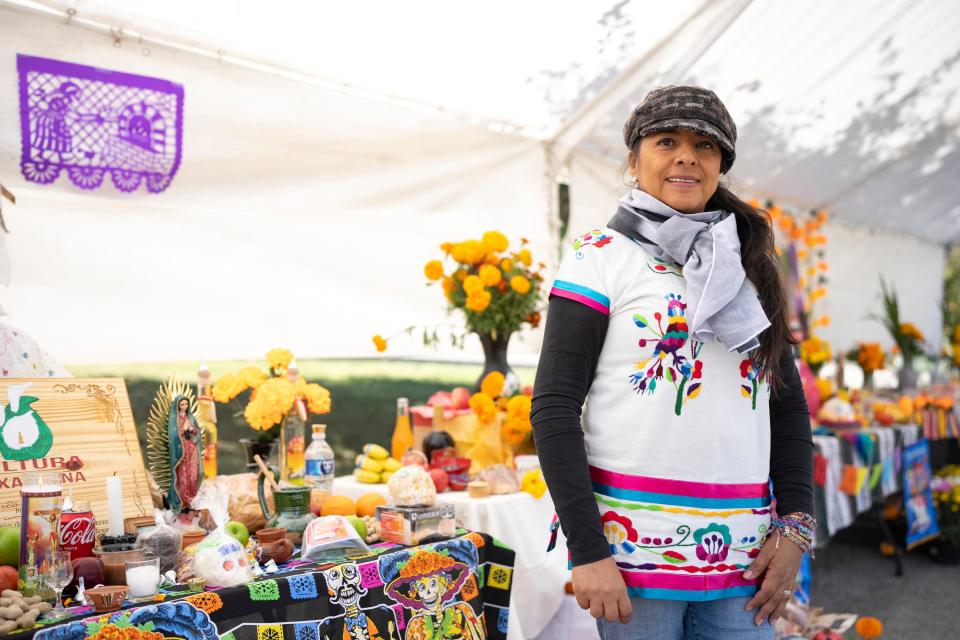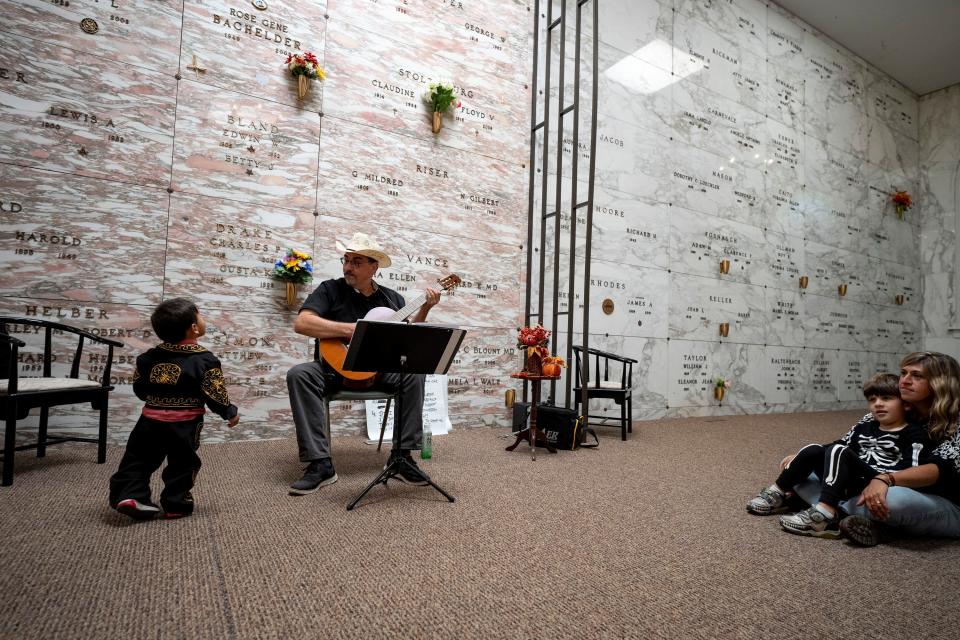Cultural Ambassador: How Leticia Vazquez-Smith brought the Day of the Dead to Columbus
A forlorn, distant train horn echoed through an otherwise quiet Green Lawn Cemetery as Leticia Vazquez-Smith unloaded skeletons from her SUV on a recent, chilly afternoon.
Vazquez-Smith, who has organized Columbus’ largest Day of the Dead celebration for the past 23 years, wore overalls and a newsboy hat. The skeletons were traditional Mexican puppets known as "mojigangas," made using a Mexican paper-mache-like technique called "cartoneria."
Vazquez-Smith inspected one puppet that had fallen prey to mice.
“The mice are crazy,” she said, but noted that cartoneria is ephemeral by nature. “Part of its beauty is it doesn’t last forever — it’s like the cycle of life.”

Behind her lay Huntington Chapel, designed by the famous Columbus architect Frank Packard and decorated by Tiffany of New York, in 1902. It is in one of the oldest sections of Green Lawn’s vast graveyard, where the city’s early industrialists and mining barons including the Hayden family are interred amidst maples, oaks and bald cypress trees.
With names on headstones such as McDonald, Loewer and Page, nothing about the setting was reminiscent of Mexico. But within 48 hours, it would be transformed into a fiesta, complete with a parade of giant dancing "calaveras" (decorative skulls), colorful artwork, food trucks and dramatic and musical performances in both Spanish and English.
Día de Muertos, or Day of the Dead, is a primarily Mexican holiday in which people honor and celebrate the lives of friends and family who have passed away.
For Vazquez-Smith, organizing the annual Columbus event has been a major part of her life’s work. She said it has grown from from a party in her small apartment into a citywide event attended by thousands — including Mexicans and others from an array of backgrounds.
“I’m in love with my culture, and I think if we share what we have, others in the community can embrace it, and we can be better as humans,” she told The Dispatch. “The Day of the Dead is really for everybody. We’re all going to die at some point.”

Day of the Dead: A celebration of life and death
When Vazquez-Smith was growing up in Mexico City in the 1970s, she learned about Día de Muertos from her father, a tourist guide, and her mother, who organized the rituals at home. They would buy "cempasuchitl" (Mexican marigold flowers) and cook special dishes, including candied "calabaza" (pumpkin) and "pan de muerto" (bread of the dead).
In their living room, they would construct an altar to their late relatives, complete with the deceased’s favorite foods, drinks and mementos from their lives. Over dinner, Vazquez-Smith and her family would reminisce.
“When we eat, we’re supposed to have, like, a relationship with the people who passed — talking about them, remembering them,” she said.
A carnival-like atmosphere would ensue at the local cemetery, where people would drink, play music, and dance around the graves into the night.
Just as most Mexicans identify as "mestizo" — a mix of indigenous and white — Día de Muertos represents a marriage of Aztec religion with Catholicism.
According to Vazquez-Smith, the precolonial version of the holiday was embedded in the Aztec sense of morality, centered on earning honor rather than fearing punishment in the afterlife.
Although the Spanish initially tried to stamp out the practice, they eventually allowed it to continue as long as it was celebrated on All Saints Day. (Similarly, Halloween was a Celtic holiday that was amalgamated with All Saints Eve by the Catholic Church in Europe.)
The holiday is celebrated in Columbus about a month early to take advantage of better weather, although Vazquez-Smith says this timing is also in line with precolonial tradition.
How Day of the Dead became a Columbus festival
When Vazquez-Smith first came to Columbus in 1999 for professional training, she gave a presentation about Day of the Dead at the Columbus International Program, a local nonprofit. Falling in love with a local man who eventually became her husband, she stayed in Ohio and the next year organized a Día de Muertos party in her apartment.
Ever-larger festivities followed annually: first in the Global Gallery, then a church basement, then a warehouse and, for the past five years, Green Lawn Cemetery.
Vazquez-Smith became president of Latino Arts for Humanity, a cultural group founded by Columbus artist Rosa Rojas, that now hosts the event with funding from Greater Columbus Arts Council and other sponsors.
Vazquez-Smith thinks Day of the Dead provides an outlet for complex emotions related to death.
“You can bring that grief but also laugh, and people can understand and accept you. You can have all these feelings coming up, and you’ll feel better,” she said.
Many of her volunteers, who were setting up tables, hanging colorful banners and assembling puppets the afternoon before the festival, said the holiday speaks to them personally.
Leila Viera, a lecturer of Portuguese at Ohio State University, explained she honors her late Brazilian grandmothers.
“Even though I’m not Mexican, the Mexican Day of the Dead has had a big influence in my life,” she said.
A grave at Green Lawn
The next morning, the cemetery had been completely transformed.
Children — many with faces painted as skulls — ran about tombstones, and incense wafted over a half-dozen altars in front of the chapel. Vendors sold tamales and souvenirs, like "alebrijes" (handicrafts depicting fantastical creatures), and hundreds of people crowded near a stage, where bands played Mexican folk, jazz and a variety of world music.
Reina Jimenes, 41, of Cleveland, said she brought her 15-year-old daughter, who was born in the U.S., to educate her about her own culture.
“It’s important to teach these things because one forgets one’s traditions,” Jimenes said in Spanish. “I told her I want her to see how life is in Mexico.”
“It’s great to celebrate our culture in a different country,” said Citlali Perez, who was born in the Mexican state of Michoacan and is a line cook on Columbus’ East Side.
Vazquez-Smith stood inside Huntington Chapel, near an exhibit of Día de Muertos-inspired art. She said that although she once planned to live out her days in Mexico, she recently picked out a plot for her grave at Green Lawn. She hopes to be part of the Columbus festival in perpetuity.
“It’s nice to know somebody’s gonna celebrate my life. I tell my friends and kids: When I die, I want a big offering, with tamales, mole, mandarina (oranges),” she said. “Don’t forget the mandarinas because I really love mandarinas!”
Peter Gill covers immigration and new American communities for The Dispatch in partnership with Report for America. You can support work like his with a tax-deductible donation to Report for America here:bit.ly/3fNsGaZ.
pgill@dispatch.com
This article originally appeared on The Columbus Dispatch: How Leticia Vazquez-Smith brought the Day of the Dead to Columbus

